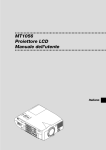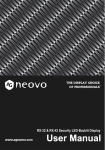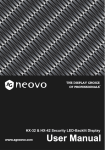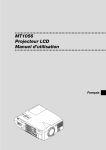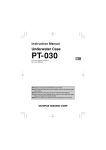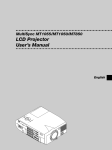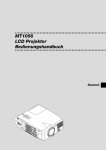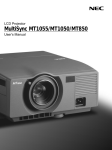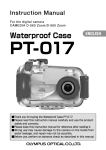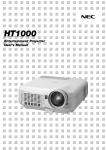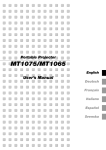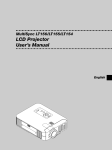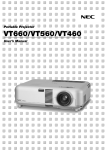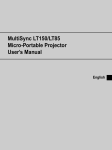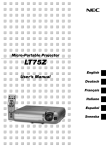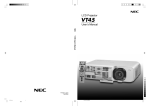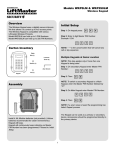Download MT1056 LCD Projector User`s Manual
Transcript
MT1056 LCD Projector User’s Manual English P O R TA E S W TU S O E NTE R N /S TA N D Y CA B S NCEL E LE C T S O U R C E M EN U A U B TO US A D JU S T C CO NT RO L MO US OU E T PC RE CO MO NT INPUR -CAR D AU DIO RG B OU MONI TP TO UT R AU DIO AC RG AU DIO S-VI DE O B IN PU T1 RG B IN PU T2 L /MO NO R VIDE O E–1 IN IMPORTANT INFORMATION Precautions CAUTION Please read this manual carefully before using your NEC MT1056 Projector and keep the manual handy for future reference. Your serial number is located under the name plate label on the left side of your MT1056. Record it here: This label is located on the side of the remote control. CAUTION To turn off main power, be sure to remove the plug from power outlet. The power outlet socket should be installed as near to the equipment as possible, and should be easily accessible. CAUTION Do not look into the laser pointer while it is on and do not point the laser beam at another person. Serious injury could result. CAUTION RF Interference TO PREVENT SHOCK, DO NOT OPEN THE CABINET. NO USER-SERVICEABLE PARTS INSIDE. REFER SERVICING TO QUALIFIED NEC SERVICE PERSONNEL. WARNING The Federal Communications Commission does not allow any modifications or changes to the unit EXCEPT those specified by NEC Solutions, Inc. in this manual. Failure to comply with this government regulation could void your right to operate this equipment. This equipment has been tested and found to comply with the limits for a Class B digital device, pursuant to Part 15 of the FCC Rules. These limits are designed to provide reasonable protection against harmful interference in a residential installation. This equipment generates, uses, and can radiate radio frequency energy and, if not installed and used in accordance with the instructions, may cause harmful interference to radio communications. However, there is no guarantee that interference will not occur in a particular installation. If this equipment does cause harmful interference to radio or television reception, which can be determined by turning the equipment off and on, the user is encouraged to try to correct the interference by one or more of the following measures: • Reorient or relocate the receiving antenna. • Increase the separation between the equipment and receiver. • Connect the equipment into an outlet on a circuit different from that to which the receiver is connected. • Consult the dealer or an experienced radio / TV technician for help. This symbol warns the user that uninsulated voltage within the unit may be sufficient to cause electrical shock. Therefore, it is dangerous to make any kind of contact with any part inside of the unit. This symbol alerts the user that important information concerning the operation and maintenance of this unit has been provided. The information should be read carefully to avoid problems. WARNING TO PREVENT FIRE OR SHOCK, DO NOT EXPOSE THIS UNIT TO RAIN OR MOISTURE. DO NOT USE THIS UNIT’S GROUNDED PLUG WITH AN EXTENSION CORD OR IN AN OUTLET UNLESS ALL THREE PRONGS CAN BE FULLY INSERTED. DO NOT OPEN THE CABINET. THERE ARE HIGH-VOLTAGE COMPONENTS INSIDE. ALL SERVICING MUST BE DONE BY QUALIFIED NEC SERVICE PERSONNEL. DOC Compliance Notice In UK, a BS approved power cable with moulded plug has a Black (five Amps) fuse installed for use with this equipment. If a power cable is not supplied with this equipment please contact your supplier. This Class B digital apparatus meets all requirements of the Canadian Interference-Causing Equipment Regulations. 3. GSGV Acoustic Noise Information Ordinance: The sound pressure level is less than 70 dB (A) according to ISO 3744 or ISO 7779. • IBM is a registered trademark of International Business Machines Corporation. • Macintosh and PowerBook are registered trademarks of Apple Computer, Inc. • Other product and company names mentioned in this user’s manual may be the trademarks of their respective holders. E–2 Important Safeguards CAUTION These safety instructions are to ensure the long life of your projector and to prevent fire and shock. Please read them carefully and heed all warnings. Do not put the projector on its side when the lamp is turned on. Doing so may cause damage to the projector. Lamp Replacement Installation 1. For best results, use your projector in a darkened room. 2. Place the projector on a flat, level surface in a dry area away from dust and moisture. 3. Do not place your projector in direct sunlight, near heaters or heat radiating appliances. 4. Exposure to direct sunlight, smoke or steam can harm internal components. 5. Handle your projector carefully. Dropping or jarring can damage internal components. 6. Do not place heavy objects on top of the projector. 7. If you wish to have the projector installed on the ceiling: a. Do not attempt to install the projector yourself. b. The projector must be installed by qualified technicians in order to ensure proper operation and reduce the risk of bodily injury. c. In addition, the ceiling must be strong enough to support the projector and the installation must be in accordance with any local building codes. d. Please consult your dealer for more information. To Dealer or Installer: To prevent the projector from falling, install it in a place and fasten it in a way with sufficient strength to support the combined weight of the projector (6.0 kg/13.3 lbs) and a ceiling mount for an extended period of time as well as to withstand earthquakes. Power Supply 1. The projector is designed to operate on a power supply of 100-120 or 200-240 V 50/60 Hz AC. Ensure that your power supply fits this requirement before attempting to use your projector. 2. Handle the power cable carefully and avoid excessive bending. A damaged cord can cause electric shock or fire. 3. If the projector is not to be used for an extended period of time, disconnect the plug from the power outlet. Cleaning 1. Unplug the projector before cleaning. 2. Clean the cabinet periodically with a damp cloth. If heavily soiled, use a mild detergent. Never use strong detergents or solvents such as alcohol or thinner. 3. Use a blower or lens paper to clean the lens, and be careful not to scratch or mar the lens. • To replace the lamp, follow all instructions provided on page E-47. • Be sure to replace the lamp when the message “The Lamp has reached the end of its usable life. Please replace the lamp.” appears. If you continue to use the lamp after the lamp has reached the end of its usable life, the lamp bulb may shatter, and pieces of glass may be scattered in the lamp case. Do not touch them as the pieces of glass may cause injury. If this happens, contact your NEC dealer for lamp replacement. • Allow a minimum of ONE minute to elapse after turning off the projector. Then disconnect the power cable and allow 60 minutes to cool the projector before replacing the lamp. Fire and Shock Precautions 1. Ensure that there is sufficient ventilation and that vents are unobstructed to prevent the build-up of heat inside your projector. Allow at least 3 inches (10 cm) of space between your projector and a wall. 2. Prevent foreign objects such as paper clips and bits of paper from falling into your projector. Do not attempt to retrieve any objects that might fall into your projector. Do not insert any metal objects such as a wire or screwdriver into your projector. If something should fall into your projector, disconnect it immediately and have the object removed by a qualified NEC service personnel. 3. Do not place any liquids on top of your projector. • Do not look into the lens while the projector is on. Serious damage to your eyes could result. • Keep any items such as magnifying glass out of the light path of the projector. The light being projected from the lens is extensive, therefore any kind of abnormal objects that can redirect light coming out of the lens, can cause unpredictable outcome such as fire or injury to the eyes. • Do not cover the lens with the supplied lens cap or equivalent while the projector is on. Doing so can lead to melting of the cap and possibly burning your hands due to the heat emitted from the light output. CAUTION Do not unplug the power cable from the wall outlet under any one of the following circumstances. Doing so can cause damage to the projector: • While the Hour Glass icon appears. • While the message “Please wait a moment.” appears. This message will be displayed after the projector is turned off. • Immediately after the power cable is plugged into the wall outlet (the POWER indicator has not changed to a steady orange glow). • Immediately after the cooling fan stops working (The cooling fan continues to work for ONE minute after the projector is turned off with the POWER button). • While the POWER and the STATUS indicators are alternately flashing. E–3 TABLE OF CONTENTS 1. INTRODUCTION Introduction to the MT1056 Projector ........................................... E-5 Getting Started ............................................................................. E-5 What’s in the Box ......................................................................... E-6 Getting to Know Your MT1056 Projector ...................................... E-7 Front / Side Features ............................................................. E-7 Rear / Side Features .............................................................. E-7 Top Features .......................................................................... E-8 Terminal Panel Features ........................................................ E-9 Remote Control Features .................................................... E-10 Remote Control Battery Installation .............................. E-12 Operating Range ........................................................... E-12 Remote Control Precautions ......................................... E-12 Setting the function switch ............................................. E-12 Switching Operation mode between computer and projector .... E-13 2. INSTALLATION Setting Up Your Projector ........................................................... Selecting a Location ................................................................... Using a Tabletop or Cart ............................................................ Adjusting the Tilt Foot ................................................................. Screen and Projection Distance ................................................. Distance Chart ........................................................................... Reflecting the Image .................................................................. Wiring Diagram .......................................................................... Connecting Your PC or Macintosh Computer ...................... Connecting Your Computer to the Mouse Output Port ......... Connecting an External Monitor .......................................... Connecting Your DVD Player ............................................... Connecting Your VCR or Laser Disc Player ......................... About Startup screen (Menu Language Select screen) ............. E-14 E-14 E-14 E-15 E-16 E-17 E-17 E-18 E-19 E-20 E-21 E-22 E-23 E-24 3. OPERATION General Controls ........................................................................ Using the Menus .................................................................. Using a USB Mouse ............................................................ Basic Operation ................................................................... Customizing Basic/Custom Menu ........................................ Menu Tree .................................................................................. Menu Elements .......................................................................... Menu Descriptions & Functions ................................................. Source Select ............................................................................. RGB1&2/Video/S-Video/PC Card Viewer Picture ........................................................................................ Brightness/Contrast/Color/Hue/Sharpness Volume ....................................................................................... Image Options ............................................................................ Keystone .............................................................................. Lamp Mode .......................................................................... Aspect Ratio ........................................................................ Noise Reduction .................................................................. Position/Clock ...................................................................... Resolution ............................................................................ Video Filter .......................................................................... Overscan ............................................................................. Factory Default .................................................................... Color Management .................................................................... Gamma Correction .............................................................. Color Correction .................................................................. Color Matrix ......................................................................... White Balance ..................................................................... Projector Options ....................................................................... Sleep Timer ......................................................................... Menu .................................................................................... Menu Mode ................................................................... Advanced Menu, Basic/Custom Menu E-25 E-25 E-25 E-26 E-28 E-30 E-31 E-32 E-32 E-32 E-32 E-33 E-33 E-33 E-33 E-33 E-33 E-34 E-34 E-34 E-34 E-34 E-34 E-34 E-35 E-35 E-35 E-35 E-35 E-35 Language ...................................................................... Projector Pointer ............................................................ Menu Display Time ........................................................ Message ........................................................................ Direct Button ................................................................. Setup ................................................................................... Orientation ..................................................................... Background ................................................................... Mouse Settings ............................................................. Button/Sensitivity PC Card Viewer Options ............................................... Capture Options ............................................................ Signal Select ................................................................. Auto Adjust (RGB only) ................................................. Auto Start ...................................................................... Power Management ...................................................... Power Off Confirmation ................................................. Keystone Save .............................................................. Fan High Speed Mode .................................................. Auto Mute for Built-in Speaker ....................................... Clear Lamp Hour Meter ................................................. Clear Filter Usage ......................................................... Remote Sensor ............................................................. S-Video Mode Select .................................................... RGBOUT Terminal ........................................................ Communication Speed .................................................. Default Source Select .................................................... Control Panel Key Lock ................................................. Tools ........................................................................................... Capture ................................................................................ PC Card Files ...................................................................... Changing Background Logo .......................................... Chalk Board ......................................................................... Help ............................................................................................ Contents .............................................................................. Information ........................................................................... Using the PC Card Viewer Function ........................................... Features ............................................................................... Inserting and Ejecting a PC Card ........................................ Installing the PC Card Viewer Software ............................... Starting Up the PC Card Viewer Software on your PC (PC Card Viewer Utility 10) ........ Operating the PC Card Viewer Function from the Projector (playback) .................................. Capturing Images Displayed on the Projector ..................... Viewing Digital Images ........................................................ Uninstalling the PC Card Viewer Software .......................... Terminology ......................................................................... E-35 E-35 E-35 E-36 E-36 E-36 E-36 E-36 E-36 E-36 E-36 E-37 E-37 E-37 E-37 E-37 E-37 E-37 E-37 E-37 E-37 E-37 E-38 E-38 E-38 E-38 E-38 E-38 E-38 E-38 E-39 E-39 E-39 E-39 E-39 E-40 E-40 E-40 E-41 E-41 E-42 E-44 E-44 E-45 E-46 4. MAINTENANCE Replacing the Lamp ................................................................... E-47 Cleaning or Replacing the Filters ............................................... E-48 5. TROUBLESHOOTING Power / Status Light Messages .................................................. E-49 Common Problems & Solutions ................................................. E-49 6. SPECIFICATIONS Optical/Electrical/Mechanical ..................................................... Cabinet Dimensions ................................................................... D-Sub Pin Assignments ............................................................. Compatible Input Signal List ...................................................... PC Control Codes ...................................................................... Cable Connection ....................................................................... E–4 E-51 E-52 E-53 E-54 E-55 E-55 1. INTRODUCTION Introduction to the MT1056 Projector This section introduces you to your new MT1056 (XGA) Projector and describes the features and controls. Congratulations on Your Purchase of The MT1056 Projector The MT1056 is one of the very best projectors available today. The MT1056 enables you to project precise images up to 300 inches (measured diagonally) from your PC or Macintosh computer (desktop or notebook), VCR, DVD player, document camera, a laser disc player or PC Card Viewer. You can use the projector on a tabletop or cart, you can use the projector to project images from behind the screen, and the projector can be permanently mounted on a ceiling*1. The remote control can be used wirelessly. *1 Do not attempt to mount the projector on a ceiling yourself. The projector must be installed by qualified technicians in order to ensure proper operation and reduce the risk of bodily injury. In addition, the ceiling must be strong enough to support the projector and the installation must be in accordance with any local building codes. Please consult your dealer for more information. *2 A UXGA (16001200) and SXGA (12801024) image are converted to an XGA (1024768) crisp image with NEC Solutions’ Advanced AccuBlend. *3 The PC Control Utility 1.0 is required. This program is included on the supplied CD-ROM. *4 The USB terminal meets the USB1.1 specification and accepts a USB mouse only. Features you’ll enjoy: • Simple set up and operation. • Hot air blown from the vents does not bother the audience during your presentation since the vents are located at the front of the projector. • A high-performance 200 watt NSH lamp. • The supplied wireless remote control that operates the projector from any angle. • The image can be projected between 30 and 300 inches (measured diagonally). • Keystone correction allows you to correct trapezoidal distortion so that the image is square. • You can choose between video modes depending on your source: “normal” for a typical picture, “natural” for true color reproduction. • The built-in PC Card Viewer allows you to start your presentation even when a PC is not available at the site. • The “Capture” enables you to capture the current projected image. • An image can be projected from in front or behind a screen, and the projector can even be installed on the ceiling. • NEC Solutions’ exclusive Advanced AccuBlend intelligent pixel blending technology - an extremely accurate image compression technology - offers a crisp image with UXGA (16001200) resolution*2. • Supports most IBM VGA, SVGA, XGA, SXGA/UXGA(with Advanced AccuBlend)*2, Macintosh, component signal (YCbCr / YPbPr) or any other RGB signals within a horizontal frequency range of 15 to 100 kHz and a vertical frequency range of 50 to 120 Hz. This includes NTSC, PAL, PAL60, SECAM and NTSC4.43 standard video signals. NOTE: Composite video standards are as follows: NTSC: U.S. TV standard for video in U.S. and Canada. PAL: TV standard used in Western Europe. PAL60: TV standard used for NTSC playback on PAL TVs. SECAM: TV standard used in France and Eastern Europe. NTSC4.43: TV standard used in Middle East countries. Getting Started The fastest way to get started is to take your time and do everything right the first time. Take a few minutes now to review the user’s manual. This may save you time later on. At the beginning of each section of the manual you’ll find an overview. If the section doesn’t apply, you can skip it. • The supplied remote control can be used without a cable, and you can even use the remote control and mouse adapter to operate your PC or Macintosh mouse wirelessly from across the room with the built-in remote mouse receiver. • You can control the projector with a PC using the PC Control port*3. • USB terminal allows USB mouse operation*4. • The contemporary cabinet design is light, compact, easy to carry, and complements any office, boardroom or auditorium. • Eight pointers are available for your presentation. E–5 What’s in the Box? Make sure your box contains everything listed. If any pieces are missing, contact your dealer. Please save the original box and packing materials if you ever need to ship your MT1056 Projector. P O E R S TA TU W String (24C05051) S O Lens cap (24FT7291) E NTE R N /S TA N D Y CA B S E LE C T NCEL S O U R C E M EN U A U TO US B A D JU S T C CO NT RO L MO US OU E T RE CO MO NT INPUR PC -CAR D Rivet (24C04534) AU DIO RG B OU MONI TP TO UT R AU DIO AU AC IN RG B IN PU T1 DIO RG S-VI DE B IN PU O L /MO T2 NO R VIDE O Batteries (AA2) NEC MT1056 projector Power cable (70810775 for North America) (70800033 for Europe) Serial cable (73499390) Mouse adapter (For IBM PS/2) (73499392) RGB signal cable (15-Pin Mini D-Sub To 15-Pin Mini D-Sub connector) (7N520001) Mouse adapter (USB) (7N520002) FF O EO VID ck t ui ec Q nn de o i C Gu (7N8P1331) Remote cable (73499391) TO AD J. N O ER B1 W G R PO AU EO ID S-V B2 G R R SE LA SE LE CT PJ FO CU S HE LP KEYS TONE r's l se a U anu M CD-ROM (7N950063) ZO OM TER MAG NIFY SH IFT PC CARD SLID E FREE ZE PICMUT E VO L. FOLD ER SLID LIST (7N8P1311) E–6 POIN E Remote control (7N900231) Getting to Know Your MT1056 Projector Front/Side Features Remote Sensor Zoom lever Controls Focus ring USB (Mouse) Terminal S TA T P O US W E R Remote Sensor Air-Filter O N E NTE R /S TA N D CA S E LE C T NCEL S O U R C E M EN B Y U A U TO US B A D JU S T C CO NT RO L MO US OU E T PC RE CO MO NT INPUR -CAR D Lenscap AU DIO RG B OU MONI TP TO UT R PC Card Slot AU DIO AU AC DIO RG Slot for Kensington Micro saver Security System IN RG B IN PU T1 S-VI DE O L /MO B IN PU T2 NO R VIDE O Air Filter AC Input Connect the supplied power cable’s threepin plug here. Terminal Panel Adjustable Tilt Foot Carrying Handle Lens Ventilation (outlet) Rear/Side Features Remote Sensor M EN U /S TA N D B Y CA S E LE C NCEL T S O U R C E A U TO A D JU S T Built-In Stereo Speaker (1W) P O W S E R TA TU S O N E NTE R Rear Foot One-touch Tilt Button Remote Sensor Lamp Cover Lamp Cover Screw Built-In Stereo Speaker (1W) Rear Foot E–7 Top Features 1 2 SOURCE AUTO ADJUST 3 MENU 4 SELECT 6 E NT L 5 ER CA NC E 7 9 STATUS ON/STAND BY POWER 8 1. Source Button Use this button to select a video source such as a PC, VCR, DVD player or PC Card Viewer (PC card). Each time this button is pressed, the input source will change as follows: → RGB1 → RGB2 → Video → S-Video → PC Card Viewer If no input signal is present, the input will be skipped. 2. Auto Adjust Button (RGB only) Use this button to adjust Position-H/V and Pixel Clock/Phase for an optimal picture. Some signals may not be displayed correctly or take time to switch between sources. 3. Menu Button Displays the menu. 4. Select ▲▼ / Volume (+) (-) Buttons ▲▼: Use these buttons to select the menu of the item you wish to adjust. When no menus appear, these buttons work as a volume control. : Use these buttons to change the level of a selected menu item. A press of the button executes the selection. When the menus or the Viewer tool bar is not displayed, these buttons can be used to select a slide, or to move the cursor in Folder List or Slide List. When the pointer is displayed, these ▲▼ buttons move the pointer. 6. Cancel Button Press this button to exit “Menus”. Press this button to return the adjustments to the last condition while you are in the adjustment or setting menu. 7. Status Indicator When this is lit red (orange in Eco mode) continually, it’s warning you that the projection lamp has exceeded 1500 hours (2500 hours in Eco mode) of service. After this light appears, it is advisable to replace the projection lamp as soon as possible. (See page E-47). In addition the message “The lamp has reached the end of its usable life. Please replace the lamp.” appears continually until the lamp is replaced. If this light blinks red rapidly, it indicates that the lamp cover is not attached properly or the projector is overheated. See the Power / Status Light Messages on page E-49 for more details. 8. Power Indicator ( ) When this indicator is green, the projector is on; when the indicator is orange, it is in standby mode. 9. Power Button (ON / STAND BY) Use this button to turn the power on and off when the power is supplied and the projector is in standby mode. NOTE: To turn off the projector, press and hold this button for a minimum of two seconds. 5. Enter Button Executes your menu selection and activates items selected from the menu. E–8 R C E EN U U B TO US A 3 M Terminal Panel Features 1 2 A D JU S T CC O NT RO L MO OU USE TP UT PC -CA RE CO MO N INPTR U RD USB 4 MOUSE PC CONTROL OUTPUT REMOTE CONTROL INPUT 14 6 5 AUDIO RGB MONITOR OUTPUT AUDIO RGB INPUT 1 AUDIO RGB INPUT 2 7 8 1. USB Terminal Connect a commercially available mouse that supports USB. You can operate the menu or PC Card Viewer with the USB mouse via this terminal. Note that this terminal is not used with a computer and that there may be some brands of USB mouse that the projector does not support. 9 10 2 PC Card Slot Push up and open the cover to access this slot. Insert a PC card here. S-VIDEO L /MONO R VIDEO 3. PC Card Access Indicator Lights while this indicator light shows that data is being. 4. PC Card Eject Button Press to eject a PC card partially. 11 5. PC Control Port (Mini DIN 8 Pin) Use this port to connect your PC to control your projector via a serial cable. This enables you to use your PC and serial communication protocol to control the projector. The NEC optional serial cable is required to use this port. Also PC Control Utility 1.0 included in the supplied CDROM must be installed on your PC. If you are writing your own program, typical PC control codes are on page E-55. A cap is put on the port at the factory. Remove the cap when using the port. 6. Mouse Output Port (Mini DIN 8 Pin) Use this port to operate your computer’s mouse functions from the remote control. 7. Remote Control Input Jack Connect your remote control cable here for wired operation. 8. Audio Monitor Output Mini Jack Connect additional external speakers here to listen to audio coming from your computer, Video or S- Video input. RGB Monitor Output Connector (Mini D-Sub 15 pin) You can use this connector to loop your computer image to an external monitor from the RGB input source. 9. RGB Audio Input 1 Connector This is where you connect RGB audio output from a computer or another RGB source. RGB Input 1 Connector (Mini D-Sub 15 pin) Connect your PC or other RGB equipment. Use the signal cable that’s supplied to connect to a PC. 12 13 10. RGB Audio Input 2 Connector This is where you connect RGB audio output from a computer or another RGB source. RGB Input 2 Connector (Mini D-Sub 15 pin) Connect your PC or other RGB equipment. Use the signal cable that’s supplied to connect to a PC. 11. S-Video Input Port Here is where you connect the S-Video input from an external source like a VCR. 12. Left Channel/Mono Audio Input Jack (RCA) This is the left channel audio input for stereo sound coming from video equipment or audio system. This also serves as your monaural audio input. (Video and S-video only) Right Channel Audio Input Jack (RCA) This is the right channel audio input for stereo sound. (Video only) NOTE: When using two Video sources simultaneously, the Left Channel Audio Input jack is available for the S-Video source only and the Right Channel Audio Input jack is available for the composite video source only. 13. Video Input Connect a VCR, DVD player, laser disc player, or document camera here to project video. ) 14. Built-in Security Slot ( This security slot supports the MicroSaver® Security System. MicroSaver® is a registered trademark of Kensington Microware Inc. The logo is trademarked and owned by Kensington Microware Inc. E–9 Remote Control Features 6. Power OFF Button If the main power is applied, you can use this button to turn your projector off. NOTE: To turn off the projector, press and hold the POWER OFF button for a minimum of two seconds. E LI S T NOTE: If you are using a Macintosh computer, you can click either the rightclick or left-click button to activate the mouse. TE U PIC E EZ E FR N AG J P M NE TO YS KE FO C U S H E LP ZO O M PO IN S TE H R IF T PC IF C Y AR D S -M LI D V E O L. FO LD ER SL ID 7. VIDEO Button Press this button to select an NTSC, PAL, SECAM or NTSC4.43 compatible video source from a VCR, DVD player, laser disc player or document camera. 8. S-VIDEO Button Press this button to select an S-Video source from a VCR. SE LE CT LAS ER RG 9. RGB 1 Button Press this button to select a video source from a computer or component equipment connected to your RGB 1 port. AUT OA RG B DJ. VID EO S-V IDE OF O PO W B2 1 ON ER F 10. RGB 2 Button Press this button to select a video source from computer or component equipment connected to your RGB 2 port. 3 1 2 1. Infrared Transmitter Direct the remote control toward the remote sensor on the projector cabinet. 11. AUTO ADJ Button Use this button to adjust an RGB source for an optimal picture. Some signals may not be displayed correctly or take time to switch between sources. 2. Laser Pointer Beams a laser light when “Laser” button is pressed. 12. LASER Button Press and hold this button to activate the laser pointer. When lit, you can use the laser to draw your audience’s attention to a red dot that you can place on any object. 3. Remote Jack Connect your remote control cable here for wired operation. 13. MENU Button Displays the menu for various settings and adjustments. 6 4 ON OFF 8 7 14. SELECT (▲▼ ) (Mouse) Button When you are in the Computer mode, these buttons work as a computer mouse. When you are in the Projector mode, which is indicated by lighting the PJ button: ▲▼: Use these buttons to select the menu of the item you wish to adjust. : Use these buttons to change the level of a selected menu item. A press of the button executes the selection. When the pointer is displayed, these ▲▼ buttons move the pointer. 5 POWER VIDEO S-VIDEO RGB1 RGB2 9 10 LASER AUTO ADJ. 11 15. ENTER (Left Click) Button When you are in the Computer mode, this button works as the mouse left button. When this button is pressed and held for a minimum of 2 seconds, the drag mode is set. When you are in the Projector mode, which is indicated by lighting the PJ button: Use this button to enter your menu selection. It works the same way as the “Enter” button on the cabinet. 12 MENU 13 14 15 EN L SELECT TE R CA NC E 16 16. CANCEL (Right Click) Button When you are in the Computer mode, this button works as the mouse right button. When you are in the Projector mode, which is indicated by lighting the PJ button: Press this button to exit “Menus”. It works the same way as the “Cancel” button on the cabinet. PJ 4. LED Flashes when any button is pressed. 5. Power ON Button If the main power is applied, you can use this button to turn your projector on. E – 10 22 FOCUS 18 21 23 24 25 26 27 ZOOM 24. MAGNIFY (+) (–) Button Use this button to adjust the image size up to 400%. When the pointer is displayed, the image is magnified about the center of the pointer. When the pointer is not displayed, the image is magnified about the center of the screen. When the image is magnified, the pointer is changed to the magnifying icon. 17 19 PJ SHIFT 20 HELP POINTER PC CARD KEYSTONE MAGNIFY FREEZE VOLUME SLIDE 28 25. FREEZE Button This button will freeze a picture. Press again to resume motion. 29 26. PICTURE MUTE Button This button turns off the image and sound for a short period of time. Press again to restore the image and sound. NOTE: When the menu is displayed, a press of this button mutes an image and sound without turning off the menu. FOLDER 30 PIC-MUTE SLIDE 31 27. VOLUME (+) (–) Button Press (+) to increase the volume and (–) to decrease it. LIST 28. PC CARD Button Press this button to select the PC Card Viewer source. 17. PJ Button Press this button to switch the Select, Cancel, and Enter buttons between the Projector mode (lit red) and the Computer mode. Press this button or any one of the Power ON/OFF, Menu, Help, Pointer, Magnify, PC Card, Folder List or Slide List buttons to switch to the Projector mode and the PJ button lights red. To switch back to the Computer mode, press the PJ button again. 18. FOCUS Button Not available on this model. 29. SLIDE (+) (–) Button Press (+) to select the next folder or slide and (–) to select the previous folder or slide. 30. FOLDER LIST Button Press this button to select PC Card Viewer source to display a list of folders included in a CompactFlash card. 31. SLIDE LIST Button Press this button to select PC Card Viewer source to display a list of slides included in a CompactFlash card. 19. ZOOM Button Not available on this model. 20. SHIFT Button Not available on this model. 21. HELP Button Provides information about operation and adjustment procedures or the set information for the current menu or adjustment during menu operation. *NOTE: The default is the Computer mode, which allows you to use the Select, Cancel, and Enter buttons as your computer mouse. When the POWER ON/ OFF, MENU, HELP, POINTER, MAGNIFY, PC CARD, FOLDER LIST, or SLIDE LIST button is pressed, the PJ button lights red to indicate that you are in the Projector mode. If no buttons are pressed within 10 seconds, the light goes out and the Projector mode is canceled. 22. POINTER Button Press this button to display one of the eight pointers; press again to hide the pointer. You can move your pointer icon to the area you want on the screen using the Select button. 23. KEYSTONE (+) (–) Button Press the (+) or (–) button to correct the keystone (trapezoidal) distortion, and make the image square. E – 11 Remote Control Battery Installation Operating Range 1. Press firmly and slide the battery cover off. 22 feet / 7 m 2. Remove both old batteries and install new ones (AA). Ensure that you have the batteries’ polarity (+/–) aligned correctly. 3. Slip the cover back over the batteries until it snaps into place. Remote Control Precautions • • • • Handle the remote control carefully. If the remote control gets wet, wipe it dry immediately. Avoid excessive heat and humidity. If you will not be using the remote control for a long time, remove the batteries. • Do not place the batteries upside down. • Do not look into the laser pointer while it is on. • Do not point the laser beam at a person. Setting the function switch Do not mix different types of batteries or new and old batteries. Note on Remote Control Operation: Pressing and holding the Select (▲, ▼, , )/ Mouse button while installing new batteries may cause malfunction or no operation. Should this happen, remove the batteries and then install them again without touching the Select/Mouse button. OFF ON There are two switches on the bottom of the battery case: an applicable projector selector switch (1) and laser enable/disable switch (2). Check the projector being used and decide whether to enable or disable laser, then set these switches as necessary using the tip of a thin ball-point pen. On this model, an applicable projector selector switch (1) is not used. Switch (2) On: Enabled (the laser lights when the LASER button is pressed) [Factory default] Off: Disabled (the laser does not light even when the LASER button is pressed) Disable the laser when using in an environment in which the unit is accessible to children. E – 12 Switching operation mode between computer and projector The three shaded buttons shown on the drawing work as a computer mouse in the Computer mode. In the Computer mode the PJ button is not lit. • When the MENU button is pressed, the PJ button lights red to indicate that you are in the Projector mode, which allows the projector menu operation using the three buttons. • When the POINTER button is pressed, the PJ button lights red to indicate that you are in the Projector mode and that the SELECT ▲, ▼, , button works as a moving button for the POINTER or magnified image. • If no buttons are pressed within 10 seconds, the PJ button’s light goes out to indicate that you are in the Computer mode. To enable the projector menu operation again, press the PJ button to light red. To move the pointer or a magnified image again, turn off the pointer and then turn on the pointer (press the POINTER button two times). • When the PJ button is lit, if you want to use the mouse function immediately, press the PJ button to return to the Computer mode (not lit). ON OFF ON OFF POWER VIDEO S-VIDEO POWER RGB1 AUTO ADJ. RGB2 VIDEO LASER AUTO ADJ. S-VIDEO MENU Works as a mouse for your computer. R CA NC E Works as the Select button on the projector. SELECT EN Works as a right-click button for your computer. E Works as the Cancel button on the projector. SHIFT Works as the Enter button on the projector. L L SELECT TE RGB2 LASER MENU EN RGB1 TE R PJ CA NC PJ Lit red Not lit FOCUS HELP ZOOM PIC-MUTE FOCUS POINTER PC CARD KEYSTONE MAGNIFY FREEZE SHIFT Works as a left-click button for your computer. VOLUME HELP SLIDE ZOOM POINTER PC CARD KEYSTONE MAGNIFY FOLDER FREEZE SLIDE PIC-MUTE LIST VOLUME SLIDE FOLDER SLIDE LIST During Computer mode: During Computer mode by pressing the ENTER button for 2 seconds or more then releasing, the drag mode is set and the drag operation can be performed simply by pressing the SELECT (▲, ▼, , ) (mouse) button. To cancel the drag mode, press the ENTER (left click) button again or press the CANCEL (right click) button. E – 13 2. INSTALLATION This section describes how to set up your MT1056 projector and how to connect video and audio sources. Selecting a Location Your MT1056 Projector is simple to set up and use. But before you get started, you must first: The further your projector is from the screen or wall, the larger the image. The minimum size the image can be is approximately 30" (0.76 m) measured diagonally when the projector is roughly 4.3 feet (1.3 m) from the wall or screen. The largest the image can be is 300" (7.6 m) when the projector is about 36.9 feet (11.3 m) from the wall or screen. 1. Determine the image size. Using a Tabletop or Cart 2. Set up a screen or select a non-glossy white wall onto which you can project your image. 1. Place your projector on a flat level surface at the optimal distance from the screen or wall so you realize the size image you want. (Avoid having bright room lighting or sun light directly on the screen Setting up Your Projector Carrying the Projector: Always carry your projector by the handle. Ensure that the power cable and any other cables connecting to video sources are disconnected before moving the projector. When moving the projector or when it is not in use, cover the lens with the lens cap. or wall where you’ll be projecting the image.) 2. Connect the power cable, remove the lens cap and turn the projector on. (If no input signal is available, the projector will display a background image.) 3. Ensure that the projector is square to the screen. Carrying handle Top view U SB ON/OFF Screen ER NT E POWER STATUS AUTO ADJUST M ENU SOURCE SELECT CAN CE L AC IN 4. Move the projector left or right to center the image horizontally on the screen. 5. To center the image vertically, lift the front edge of the projector and press the One-Touch Tilt button on the front-left side of the projector to release the Front Adjustable foot. Attaching the lens cap to the bottom of the projector with the supplied string and rivet. Side view Screen Lens cap String Rivet (There is approximately 10 degrees of up and down adjustment for the front of the projector.) 6. If the projected image does not appear square to the screen then use keystone correction for proper adjustment. 7. Adjust the size of the image using the Zoom lever on the lens. AC E – 14 IN Adjusting the Tilt Foot Press and hold the Tilt button on the left side of the projector. ON /O FF ENTE R CAN CEL SE LE CT N U ST AT PO US WE R ME AU TO AD JU ST SO UR CE AC IN Lift the front edge of the projector to the height you want, and release the button to lock the Adjustable Tilt Foot. ON /O FF CEL SE LE CT N U ENTE R CAN ST AT PO US WE R ME AU TO AD JU ST SO UR CE AC IN To fine-tune the image’s position vertically on the screen, rotate the foot. Each of the rear feet height can be changed up to 0.6" (4mm). E – 15 Screen and Projection Distance The following shows the proper relative positions of the projector and screen. Refer to the table to determine the position of installation. Sc re 55 en s 8.8 iz (W e (Un ) it: cm 41 /in 9.1 ch (H 48 )/ ) 7.7 22 0( (W W) ) 36 16 5.8 5( (H H) )/ 1 9 40 2( 6.4 W) (W ) 14 4( 30 H) 4.8 (H )/ 16 0( W) 30 24 4.8 0" 12 (W 0( ) H) 22 8.6 24 (H 3.8 )/ 12 (W 20 0( ) 0" W) 20 18 3.2 2.9 90 (W (H (H ) )/ ) 96 15 (W 2.4 16 ) 2.6 (H )/ 72 (W 80 ) (H 15 (W ) 0" 12 ) 12 1 1.9 .9 6 (H 0( (W )/ H) ) 64 81 (W 12 91 .3 .4 ) 0" (W (H 48 )/ ) 67 4 ( H .1 8 61 10 ) (W (W .0 0" ) ) (H TE )/ L 36 50 32 61 E: 3 .3 (H ( .0 0" 8 W ) (H 0" (W ) )/ ) 26 24 (W 45 (H ) .7 6 ) 0" (H 20 )/ (H 24 ) (W 40 ) 33" " 18 (H ) Throw distance Screen WI D 60 E : 9.6 30 (W 0" ) 27 5" 45 7.2 (H )/ 3 4. 2 nte D is ta nc e (U ni t: m /fe et ) r E – 16 .3 /3 6 .9 .5 ce 11 9/ 32 8. 9. 2/ 27 .2 20 2/ .1 9/ 16 4. 6. 13 .0 .4 .5 4. 1/ 2/ 10 3. 2. 4/ 7. 9 5. 6/ 1. ns 0( W) 18 0( 3/ 1. Le 24 H) Distance Chart Throw Distance (C) Screen top Screen center B Lens Center D B = Vertical distance between lens center and screen center C = Throw distance D = Vertical distance between lens center and screen bottom (screen top for ceiling installation) Throw Angle (α) 2.9" (79.5mm) Projector Foot Screen Bottom WARNING • Installing your projector on the ceiling must be done by a qualified technician. Contact your NEC dealer for more information. * Do not attempt to install the projector yourself. • Only use your projector on a solid, level surface. If the projector falls to the ground, you can be injured and the projector severely damaged. • Do not use the projector where temperatures vary greatly. The projector must be used at temperatures between 32°F (0°C) and 95°F (35°C). • Do not expose the projector to moisture, dust, or smoke. This will harm the screen image. • Ensure that you have adequate ventilation around your projector so heat can dissipate. Do not cover the vents on the side or the front of the projector. Ceiling Installation Screen top D Lens Center B Projector Foot 2.9" (79.5mm) Throw Angle (α) Screen center Screen Bottom Throw Distance (C) If your projector is mounted on the ceiling and your image is upside down, use the “Menu” and “Select” buttons on your projector cabinet or ▲▼ button on your remote control to correct the orientation. (See page E-36.) Reflecting the Image Using a mirror to reflect your projector’s image enables you to enjoy a much larger image. Contact your NEC dealer if you need a mirror. If you’re using a mirror and your image is inverted, use the “Menu” and “Select” buttons on your projector cabinet or ▲▼ buttons on your remote control to correct the orientation. (See page E-36.) Diagonal 30 762 40 1016 60 1524 67 1701.8 72 1828.8 84 2133.6 90 2286 100 2540 120 3048 150 3810 180 4572 210 5334 240 6096 270 6858 300 7620 inch mm inch mm inch mm inch mm inch mm inch mm inch mm inch mm inch mm inch mm inch mm inch mm inch mm inch mm inch mm Screen Size Width 24 609.6 32 812.8 48 1219.2 53.6 1361.44 57.6 1463.04 67.2 1706.88 72 1828.8 80 2032 96 2438.4 120 3048 144 3657.6 168 4267.2 192 4876.8 216 5486.4 240 6096 inch mm inch mm inch mm inch mm inch mm inch mm inch mm inch mm inch mm inch mm inch mm inch mm inch mm inch mm inch mm B C Height 18 457.2 24 609.6 36 914.4 40.2 1021.08 43.2 1097.28 50.4 1280.16 54 1371.6 60 1524 72 1828.8 90 2286 108 2743.2 126 3200.4 144 3657.6 162 4114.8 180 4572 inch mm inch mm inch mm inch mm inch mm inch mm inch mm inch mm inch mm inch mm inch mm inch mm inch mm inch mm inch mm 7.7 194.6 10.2 259.5 15.3 389.2 17.1 434.7 18.4 467.1 21.5 544.9 23.0 583.9 25.5 648.7 30.6 778.5 38.3 973.1 46.0 1167.7 53.6 1362.3 61.3 1557.0 69.0 1751.6 76.6 1946.2 inch mm inch mm inch mm inch mm inch mm inch mm inch mm inch mm inch mm inch mm inch mm inch mm inch mm inch mm inch mm 41.4 1052.6 56.3 1430.3 86.1 2185.8 96.5 2450.2 103.9 2639.0 121.7 3092.3 130.7 3318.9 145.5 3696.6 175.3 4452.1 219.9 5585.2 264.5 6718.4 309.1 7851.5 353.7 8984.7 398.3 10117.8 443.0 11251.0 α D wide telephoto inch mm inch mm inch mm inch mm inch mm inch mm inch mm inch mm inch mm inch mm inch mm inch mm inch mm inch mm inch mm – – – – – – – – – – – – – – – 50.8 1290.5 68.6 1743.7 104.3 2649.9 116.8 2967.1 125.7 3193.7 147.1 3737.4 157.8 4009.3 175.7 4462.4 211.4 5368.7 264.9 6728.0 318.4 8087.4 371.9 9446.8 425.4 10806.2 479.0 12165.5 532.5 13524.9 NOTE: Distances may vary +/–5%. E – 17 inch mm inch mm inch mm inch mm inch mm inch mm inch mm inch mm inch mm inch mm inch mm inch mm inch mm inch mm inch mm wide 1.3 34.0 1.8 45.3 2.7 68.0 3.0 75.9 3.2 81.5 3.7 95.1 4.0 101.9 4.5 113.3 5.4 135.9 6.7 169.9 8.0 203.9 9.4 237.9 10.7 271.8 12.0 305.8 13.4 339.8 inch mm inch mm inch mm inch mm inch mm inch mm inch mm inch mm inch mm inch mm inch mm inch mm inch mm inch mm inch mm telephoto 10.5 degree – 8.6 degree 10.3 degree – 8.5 degree 10.1 degree – 8.4 degree 10.1 degree – 8.3 degree 10.0 degree – 8.3 degree 10.0 degree – 8.3 degree 10.0 degree – 8.3 degree 10.0 degree – 8.3 degree 9.9 degree – 8.3 degree 9.9 degree – 8.2 degree 9.9 degree – 8.2 degree 9.8 degree – 8.2 degree 9.8 degree – 8.2 degree 9.8 degree – 8.2 degree 9.8 degree – 8.2 degree Wiring Diagram Monitor Supplied mouse adapter (For USB) Supplied serial cable MOUSE PC CONTROL OUTPUT Macintosh or Compatibles (Desktop type or notebook type) REMOTE CONTROL INPUT AUDIO RGB MONITOR OUTPUT AUDIO RGB INPUT 1 AUDIO RGB INPUT 2 Supplied mouse adapter (For IBM PS/2 or USB) IBM VGA or Compatibles (Desktop type or notebook type) Signal cable (supplied) S-VIDEO L /MONO R Optional 15-pin-to-RCA (female)3 cable (ADP-CV1) To mini D-Sub 15-pin connector on the projector. It is recommended that you use a commercially available distribution amplifier if connecting a signal cable longer than the one supplied. VIDEO DVD Player (with component output) Component video cable RCA3 (not supplied) To video, S-video, and audio inputs on the projector. Document Camera VCR, DVD Player or LaserDisc Player NOTE: When using with a notebook PC, be sure to connect between the projector and the notebook PC before turning on the power to the notebook PC. In most cases signal cannot be output from RGB output unless the notebook PC is turned on after connecting with the projector. NOTE: If using video, S-video, or audio cables, the cables should be 3 m (9.8 feet) or shorter. Remote Control Guideline 1. Plug the supplied serial cable with the mouse output port of the projector into your computer’s mouse port and restart your computer to gain remote mouse control. 2. When using the remote control’s built-in infrared mouse on a laptop computer, the laptop’s mouse, trackball or trackpad will be disabled. Disconnect the serial cable from the mouse output port and restart your computer to regain trackball or trackpad mouse control. 3. If the screen goes blank while using your remote control, it may be the result of the computer’s screen-saver or power management software. 4. If you accidentally hit the OFF button on the remote control, wait one full minute and then press the ON button to resume. E – 18 Connecting Your PC or Macintosh Computer IBM VGA or Compatibles (Notebook type) or Macintosh (Notebook type) O R TA E S W TU S O N /S TA N D E NTE R S E LE C T CA N C EL B Y S O U R E M EN U A US B C U TO A D JU S T To mini D-Sub 15-pin connector on the projector. It is recommended that you use a commercially available distribution amplifier if connecting a signal cable longer than the one supplied. P RGB signal cable (supplied) C CO NTR OL MO USE OU T REM CO O NTR INP PC -CA RD U AUD IO RG B OU MONIT TPU OR T AUD IO RG B INP UT AUD IO S-V IDE O AU DIO 1 RG B INP UT AC R VID EO AU AU DIO DIO RG S-V IDE O RG B IN PU T1 AU DIO Audio cable (not supplied) IN RG B OU MON TP ITO UT R 2 L /MO NO BI NP UT RG B IN PU T2 L /M ON O R IBM VGA or Compatibles (Desktop type) VID EO Macintosh (Desktop type) The new Macintosh computer such as G3 will have the 15 pin HD connector. The MT1056’s “Plug and Play” data will be downloaded to the Macintosh. Therefore, a Mac adapter will not be necessary. DIP ON 1 2 3 4 5 Connecting your PC or Macintosh computer to your MT1056 (XGA) projector will enable you to project your computer’s screen image for an impressive presentation. To connect to a PC or Macintosh, simply: 1. Turn off the power to your projector and computer. 2. Use the signal cable that’s supplied to connect your PC or Macintosh computer to the projector. 3. Turn on the projector and the computer. 4. If the projector goes blank after a period of inactivity, it may be caused by a screen saver installed on the computer you’ve connected to the projector. 6 Pin adapter for Macintosh (not supplied) For older Macintosh, use a commercially available pin adapter to connect to your Mac’s video port. E – 19 Connecting Your Computer to the Mouse Output Port Using Remote Mouse Function The built-in remote mouse receiver enables you to operate your computer’s mouse functions from the remote control (Computer mode). It is a great convenience for clicking through your computer-generated presentations. To return to the Projector mode, press the PJ button (lit red). Connecting your computer to the mouse output port If you wish to use the remote mouse function, connect the mouse output port and computer. The mouse output port can be connected directly to the computer using the USB terminal. To connect it to the computer using the mouse (PS/2) terminal, do so using the PS/2 adapter. NOTE: Depending on the type of connection or OS installed on your computer, you may have to restart your computer or change your computer settings. IBM PS/2 P O R TA E S W TU S E NTE R N /S TA N D B S E LE C T CA N C EL Y S O U R E EN U A D JU S T U TO REM CO O NTR INP U MO USE OU T A C CO NTR OL C MO OU USE TP UT US B M NT RO L O MO OU USE TP UT RE CO MO N INPTR U PC -CA RD AUD IO RG B OU MONIT TPU OR T AUD IO AC RG B INP UT AUD IO S-V IDE O IN 1 RG B INP UT 2 L /MO NO Mouse adapter (For IBM PS/2) (supplied) R VID EO Macintosh with USB Port Serial cable (supplied) Mouse adapter (USB) (supplied) The built-in remote mouse receiver enables you to operate your computer’s mouse functions from the remote control. It is a great convenience for clicking through your computer-generated presentations. To connect the mouse output port: 1. Turn off your computer. 2. For PCs: Remove your current mouse and connect the supplied serial cable from the mouse output to your PC’s mouse port. (Use the 6-pin adapter for connecting to a PS/2 computer or the supplied USB adapter.) For Macintosh: Attach the supplied mouse adapter for USB to the mouse output port’s serial cable and connect the projector to your USB port of a Macintosh computer. 3. When the built-in remote mouse receiver is available, it will disable your regular mouse, disconnect the serial cable and restart your computer. NOTE: The mouse adapter for USB is not compatible with the USB terminal on the projector. When connecting using the USB terminal For PC, the mouse receiver can only be used with a Windows 98/2000/Me/XP operating system. NOTE: • Wait at least 5 seconds after disconnecting the mouse receiver before reconnecting it and vice versa. The computer may not identify the mouse receiver if it is repeatedly connected and disconnected in rapid intervals. E – 20 Connecting an External Monitor S TA TU P O W S E R O N /S TA N D E NTE R S E LE C T CA N C EL M S O U R C E EN B Y U A U TO US B A D JU S T C CO NTR OL External monitor MO USE OU T AU PC -CA RD REM CO O NTR INP DIO U OU AUD IO T RG B OU MONIT TPU OR T AU DIO AUD IO AC RG B INP UT AUD IO AU S-V IDE O DIO R IN IN 1 RG B INP UT L /MO NO 2 RG B OU MON TP ITO UT R RG VID EO BO UT AU DIO PU RG T B IN PU T1 RG AU DIO S-V IDE O BI RG B IN PU T2 NP UT L /M ON O R VID EO RGB Signal cable (suppried) You can connect a separate, external monitor to your MT1056 to simultaneously view on a monitor the image you’re projecting. To do so: 1. Turn off the power to your projector, monitor and computer. 2. Use a 15-pin cable to connect your monitor to the RGB Monitor Output (Mini D-Sub 15 pin) connector on your projector. 3. Turn on the projector, monitor and the computer. E – 21 Connecting Your DVD Player DVD player S TA TU P O W S E R O N /S TA N D E NTE R S E LE C T S O U R C E M EN CA N C EL B Y U A U TO US B A D JU S T C CO NTR OL MO USE OU T REM CO O NTR INP PC -CA RD U AU R DI AUD IO AU DIO O AC RG B INP UT AUD IO L Co m Y pon Cb ent Cr Red White RG B OU MONIT TPU OR T AUD IO S-V IDE O R IN 1 RG B INP UT L /MO NO 2 RG B OU MON TP ITO UT R VID EO AU DIO RG B Y RG INP UT 1 AU BI NP DIO Cb UT RG Cr B IN PU S-V T2 IDE O L /M ON O R VID EO Component video cable RCA3 (not supplied) Optional 15-pin-to-RCA (female)3 cable (ADP-CV1) Audio Equipment AU R DI O L Red White Audio cable (not supplied) You can connect your projector to a DVD player with component outputs or Video output. To do so, simply: 1. Turn off the power to your projector and DVD player. 2. If your DVD player has the component video (Y/Cb/Cr) output, use a commercially available component video cable (RCA3) and the optional 15-pin-to-RCA (female)3 cable to connect your DVD player to the RGB INPUT connector on the projector. For a DVD player without component video (Y/Cb/Cr) outputs, use common RCA cables (not provided) to connect a composite VIDEO output of the DVD player to the Video Input of the projector. 3. Turn on the projector and DVD player. NOTE: Refer to your DVD player’s owner’s manual for more information about your DVD player’s video output requirements, E – 22 Connecting Your VCR or Laser Disc Player S TA TU P O W S E R O N /S TA N D E NTE R S E LE C T S O U R C E M EN CA N C EL B Y U A U TO US B A D JU S T VCR/ Laser disc player C CO NTR OL MO USE OU T REM CO O NTR INP PC -CA RD U AU DIO AUD IO RG B OU MONIT TPU OR T RG B OU MON TP ITO UT R AUD IO RG B INP UT AUD IO S-V IDE O 1 RG B INP UT 2 L /MO NO R DIO RG B INP UT AU 1 DIO IDE O RG B IN PU S-V T2 IDE L IN AU VID EO S-V AC O L /M R ON O S-video cable (not supplied) VID R VID EO EO Audio cable (not supplied) Audio equipment Video cable (not supplied) VID EO L R Document camera Use common RCA cables (not provided) to connect your VCR, laser disc player or document camera to your projector. To make these connections, simply: 1. Turn off the power to the projector and VCR, laser disc player or document camera. 2. Connect one end of your RCA cable to the video output connector on the back of your VCR or laser disc player, connect the other end to the Video input on your projector. Use an audio cable (not supplied) to connect the audio from your VCR or laser disc player to your audio equipment (if your VCR or laser disc player has this capability). Be careful to keep your right and left channel connections correct for stereo sound. 3. Turn on the projector and the VCR or laser disc player. NOTE: Refer to your VCR or laser disc player owner’s manual for more information about your equipment’s video output requirements. E – 23 About Startup screen (Menu Language Select screen) When you first turn on the projector, you will get the Startup screen. This screen gives you the opportunity to select one of the seven menu languages: English, German, French, Itilan, Spanish, Swedish and Japanese. To select a menu language, follow these steps: 1. Use the Select ▲ or ▼ button to select one of the seven languages for the menu. 2. Press the Enter button to execute the selection. 3. The Basic/Custom menu will be displayed in the language you have selected. To close the menu, press the Cancel button. After this has been done, you can proceed to the advanced menu operation. If you want, you can select the menu language later. See “Language” on page E-35. E – 24
























